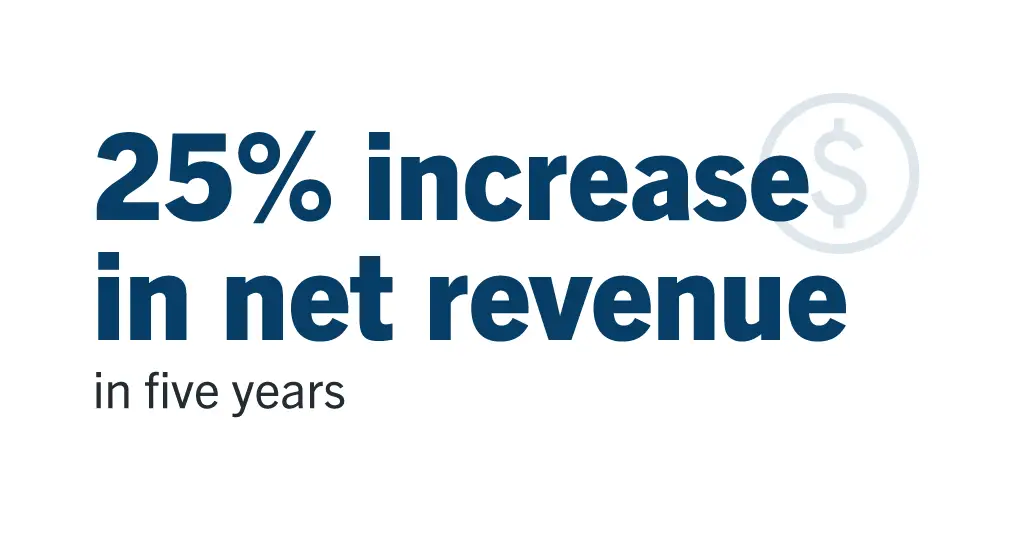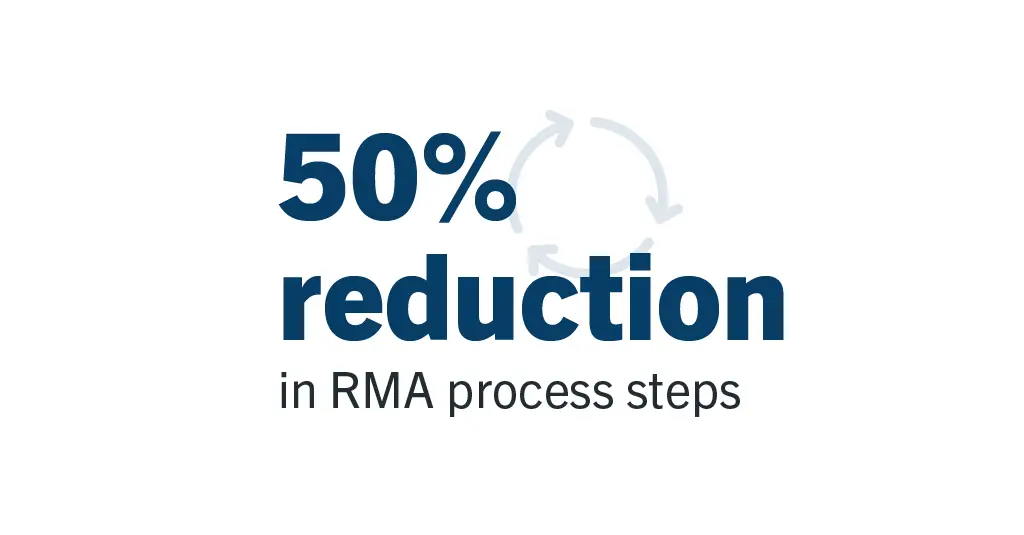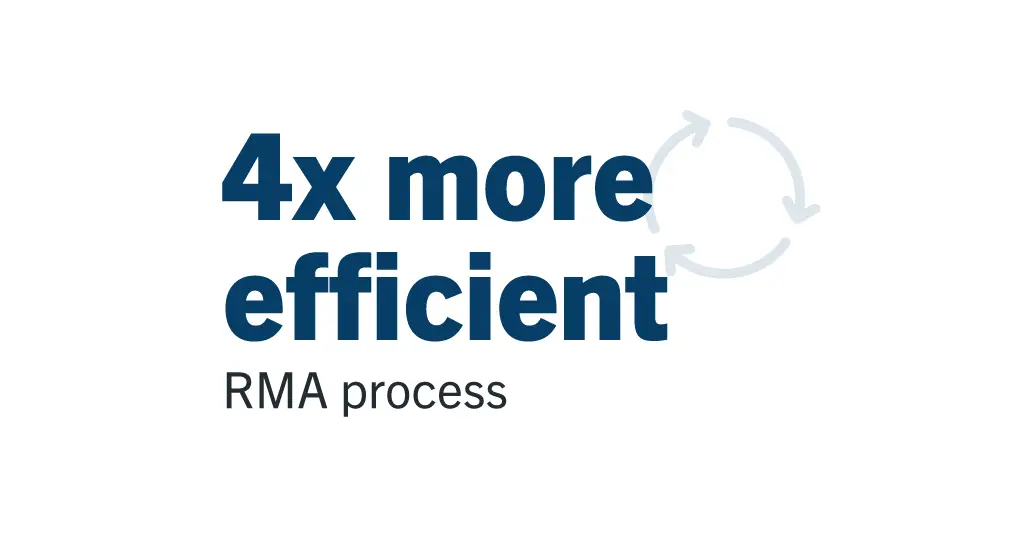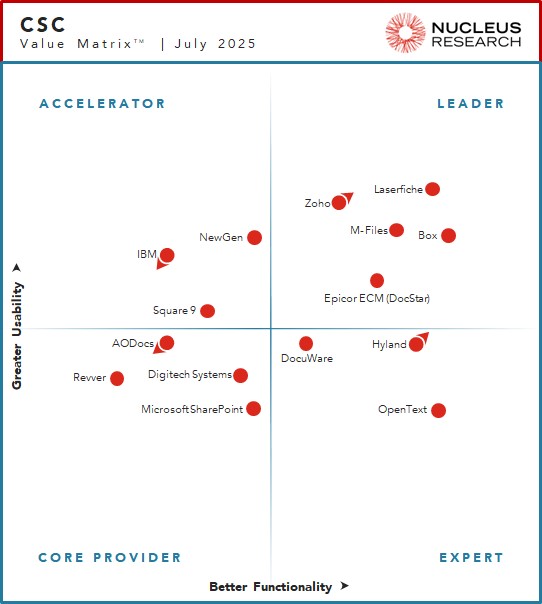- Product
-
-
Product Features
-
Explore More
-
-
- Solutions
-
-
By Industry
By Department
-
By Business Need
-
-
- Learn & Support
-
-
Product Education
-
Product Support
-
-
- Resources
-
-
Insights
Events
-
-
- Partners
-
Join us in Chicago!

Imagine a 25% increase in net revenue over five years without adding additional staff. Airline Hydraulics — a distributor of industrial technologies for a broad range of markets — made this a reality using Laserfiche.
Managing data associated with Airline Hydraulics’ myriad products and custom-engineered technology solutions requires robust information handling processes and procedures. However, with information coming from many sources — suppliers, customers, sales and other departments — the organization needed a way to standardize data collection and dissemination.

Driven to better manage the company’s data to optimize operations, the team implemented Laserfiche.
“Laserfiche was a solution that gave us the best of both worlds: the forms and workflow processes as well as the data integration,” said Todd Schnirel, CTO and director of business development and agility. “We’re now able to record and mine that data for trends and outliers — the potential that Laserfiche unlocked with our data was really the differentiator for us.”
The company has since reduced the time and effort wasted on outdated processes, using Laserfiche to:
“We’re a 100% employee-owned company, so everyone has a stake in organizational efficiency,” said Schnirel. “If you add 25% to the top line and add very little to your operating expense, the money goes right into the profitability of the organization. And for us, that gets distributed amongst the employees.”
Airline Hydraulics’ business dates back to 1949, when the company focused on equipment used in conjunction with factory air lines. Since then, the company has grown in size and in offerings. With this growth, the organization has had to scale operations, which proved challenging without standardized business processes. Information about requests was trapped in PDF documents that bounced back and forth via email and had to be manually typed into the ERP system. This manual approach led to inaccurate data; every employee’s unique method for recording data led to inconsistencies.
“If you’ve got 20 different people they might have 10 different ways to do something,” said Schnirel. “The person who’s then on the receiving end has to deal with all those differentiators.”
The company’s ERP system, Epicor, also lacked the right automation, analytics and data validation tools that would support more standardized data collection. Teams like business development or accounting couldn’t take quick action on requests from sales, customers and suppliers when they received incomplete or inaccurate data. To create more consistency in processes, the team now uses Laserfiche Forms and workflow.
For example, they created a new vendor management form, critical for managing data about the organization’s hundreds of approved suppliers. Previously a very manual process, vendor management often required the accounting team to follow up with requestors to collect W-9s and other information. Misspellings and “bad data” being entered in Epicor was commonplace.
“Laserfiche allows us to do data validation, and we can flush out inaccuracies before we put bad data into our ERP system. Laserfiche definitely helps to keep our Epicor database clean.”
Todd Schnirel, CTO and director of business development and agility
Additionally, the team can now enforce certain procedures — such as collection of vendor W-9s — by not allowing a form to be submitted without the necessary documentation. Laserfiche’s integration with Epicor facilitates the data entry process, avoiding duplicate manual entry. “If we can make a task 10 minutes faster, and we continuously do this, we are making processes faster by hours over time,” added Schnirel. “So that’s our approach. It really starts to add up.” In addition to time savings, the organization avoided replacing their ERP system, saving around $2.5 million in initial costs.
Without application switching or excessive data entry, staff can now focus on higher-value tasks. There are fewer manual errors and less stress around data accuracy. The new solution has also opened the door to more analysis of manual tasks and process optimization.

Airline Hydraulics’ return material authorization process (RMA) is a prime example of how the team used Laserfiche to automate a complex process. Prior to Laserfiche, RMAs relied on multiple manual steps, and often resulted in inaccurate records.
“The RMA process was many, many emails through many different people, and there was no trackability,” said Jennifer McCalicher, product data team manager at Airline Hydraulics. McCalicher and her team spent hours hunting down information that should have been provided with the initial request.
The business development team streamlined the RMA process, again with Laserfiche Forms and workflow.
The new process introduced:
Laserfiche also automatically creates associated Epicor records upon RMA approval, as well as a packing list.
The organization has since reduced the time to complete this process from more than a month to less than a week.

RMA process optimization resulted in:
Beyond the RMA process, the organization implemented a similar solution for special pricing agreements (SPAs).
“Originally this would go into a ticket system,” said McCalicher. “Someone would then have to review the documentation and get it into our ERP system.”
The team replaced this ticket system with a one-stop form that makes it easy for on-the-go salespeople to get pricing approved quickly and secure orders faster. Data is pulled directly from Epicor to make it easier for salespeople to properly fill out required fields. Workflow routes agreements to the pricing department for approval, giving the organization more control over pricing strategy. Finally, more accurate data in Epicor means better financial reporting and easier audits.
With the business development team’s achievements with internal processes, they are now looking to expand Laserfiche to customer-facing processes. Schnirel expects to see more improvements in efficiency organization-wide. With Laserfiche’s low-code automation tools, the company’s business users can build most of these processes with ease, even without deep technical or coding skills.
“Our team is not made up of developers; they’re not programmers; but they’re able to create all this because of the tool set that exists within Laserfiche,” said Schnirel. “This was a huge differentiator for Laserfiche, this workflow ability and having the whole gamut of programmability from HTTP requests and JSON creators and VB scripting and all the different kind of advanced stuff you can do, but in a very visual, very low-code way.”
Internally, the team has seen a culture of automation and optimization spreading throughout the company. “As we’ve deployed it departmentally, it’s picking up a lot of momentum,” said Schnirel. “We’re getting that snowball rolling down the hill effect. We’re constantly receiving requests for new forms and new processes.”
“At Airline, we look at processes through the lens of, ‘How can we do that more efficiently, so it can benefit all of us?’” said McCalicher. “The amount we can do within these workflows is amazing.”
LONG BEACH, CALIFORNIA, August 13, 2025 — Laserfiche, the leading SaaS provider of intelligent content management and business process automation, today released new survey findings on AI adoption in the workplace, revealing that nearly half of Americans (49%) who use AI at work keep it to themselves, with 15% deliberately avoiding telling their manager.
As AI tools become more embedded in daily life, the survey reveals a workplace reality that is far less aligned. While many employees are eager to harness AI to boost productivity, inconsistent policies and cultural hesitation are fueling secrecy around AI adoption at work. Employees who are hiding their AI use worry it will be seen as lazy (16%), risky (15%), or out of step with company policy (16%).
Employee sentiment around AI remains divided. While 21% are optimistic, and 22% say AI already helps them work faster or more efficiently, others are more cautious. Nineteen percent are skeptical, citing concerns about accuracy or misuse, and 13% are anxious or resistant, uneasy about the risks and consequences of incorporating AI into their workflows.
Younger generations are more optimistic about AI at work: 24% of Gen Z and 20% of Millennials say they see its potential but are still learning how to use it, compared to just 10% of Baby Boomers.
Only one in three employees (36%) say their workplace has clear policies and approved AI tools in place. Meanwhile, 1 in 10 describe their organization’s AI environment as “the Wild West,” an unregulated space where people do what they want.
That lack of structure has consequences. Nearly half of employees (46%) admit to pasting company information into public AI tools, such as ChatGPT or Google Gemini, sometimes without knowing if the content is sensitive or confidential. Many turn to these tools in an attempt to gain a competitive edge (24%) or because their company’s own tools are too limited or hard to use (23%).
Older employees are significantly more cautious about using unofficial AI tools at work: 69% of Baby Boomers and the Silent Generation, and 35% of Gen X, avoid these tools, compared to just 21% of Millennials and 17% of Gen Z.
These findings highlight a growing AI governance gap. Usage is outpacing policy, and fear is replacing transparency. To solve this, organizations must do more than roll out AI tools. They need to foster a culture where employees feel informed, supported, and aligned on how and when to use them.
“When employees feel like AI is their ‘dirty little secret,’ that’s not a tech problem, it’s a leadership one,” said Karl Chan, CEO of Laserfiche. “Many employees are eager to embrace AI to work but often resort to unofficial tools when company-approved options are too limited or difficult to use. Innovative organizations can meet employee needs and unlock new potential by implementing guidelines, and adopting IT-vetted, intuitive AI tools that help employees reach productivity goals.”
The survey was conducted by Veridata Insights and commissioned by Laserfiche. It included 1,000 U.S.-based individuals aged 18 and over, census-balanced by age and gender.
About Laserfiche
Laserfiche is a leading enterprise platform that helps organizations digitally transform operations and manage their content with AI-powered solutions. Through scalable workflows, customizable forms, no-code templates and AI-enabled capabilities, the Laserfiche® document management platform accelerates how business gets done. Trusted by organizations of all sizes — from startups to Fortune 500 enterprises — Laserfiche empowers teams to boost productivity, foster collaboration, and deliver a superior customer experience at scale. Headquartered in Long Beach, California, Laserfiche operates globally, with offices across North America, Europe, and Asia.
Amid a prolonged workforce shortage, increasing order volume, SKU proliferation, pressure to speed up delivery times and lingering economic uncertainty, factories and warehouses are turning to AI-powered technologies to automate time-consuming tasks. But for all their investments in digital transformation, many supply-chain organizations are still performing essential tasks manually, leading to a high volume of paperwork, frequent data silos, manual approval processes and a lack of visibility. All those manual tasks tap the brakes on production countless times each day.
As generative AI (GenAI) rapidly gains a foothold in supply chain operations, leaders in the manufacturing and distribution industries are recognizing the power of automation and GenAI to drive process improvements, according to the 2025 MHI Annual Industry Report. With strategic digital implementation of GenAI, supply-chain companies can streamline laborious processes, automate data extraction and eliminate bottlenecks, driving significant operational gains across the organization. This eBook will explore how enterprise content management (ECM) solutions—such as Long Beach, Calif.-based SaaS provider Laserfiche®—can help manufacturers and distributors become more agile, efficient and responsive to the ever-changing dynamics of supply-chain operations.
The 2025 MHI Annual Industry Report shows that supply-chain executives understand the value of ECM solutions such as Laserfiche. The survey found that 51% of organizations are working to accelerate their digital transformation by harnessing the power of data, but without an ECM solution, that task is daunting. MHI’s report found that 44% of manufacturing leaders say the amount of data their companies collect has doubled in just the past two years, and they expect it to triple by 2030.
Spreadsheets remain ubiquitous, with 70% of manufacturers entering data manually and 68% still using spreadsheets to analyze data, according to the MHI report. The tedious nature of data entry is just one of the factors contributing to the manufacturing industry’s labor shortage, which is expected to reach 2.1 million unfilled jobs by 2030, according to the report.
The amount of data associated with supply-chain operations is growing exponentially, and managing that data is essential, empowering manufacturing leaders to identify bottlenecks and make strategic decisions more quickly. Manual data management and data silos lead not only to wasted time and increased costs but also to complicated processes and frustration for workers and customers.
Through automated data structures, streamlined data extractions and data uniformity across documents, executives can make informed decisions as challenges arise, supporting critical business processes and driving ROI for their organizations. Clean data starts with evaluating how well existing software systems and business processes are integrated. The next step is to bridge the process gaps between applications such as enterprise resource planning, manufacturing execution and customer relationship management. A centralized repository platform such as Laserfiche can serve as the single trusted source for up-to-date information, and that accuracy improves strategic planning and decision-making.
Data silos make it all but impossible to drive efficiency and streamline business processes across multiple applications and business units. That lack of transparency also makes it harder to measure ROIs and improve margins over time. By eliminating fragmentation across information systems, organizations can work and communicate seamlessly across diverse functions such as sales, engineering and finance.
Low-code integrations with Laserfiche’s platform enable companies to bridge technology gaps between legacy systems and the latest cloud applications while extending the functionality of existing ERP and supply-chain management solutions. Integrating content through a middleware platform like Laserfiche allows for standardized data formats and metadata types, enabling people and systems to access accurate information consistently.
With reliable data available across the entire company, manufacturers and warehouses can move products faster and grow their margins. Supply-chain companies will gain visibility and control over their factory or warehouse floor, and they’ll harness the power of AI and predictive modeling to establish an edge over their competitors.
Supervisors can create customizable dashboards to monitor operations, and Laserfiche’s generative AI tools, Smart Fields and Smart Chat, can speed-up real-time data extraction from multiple document types with less manual effort, and improved accuracy and compliance.
Here are five ways Laserfiche’s ECM platform can optimize operations for supply-chain companies:
Want to read more? Get the full ebook, 5 Steps to Boost Supply-Chain Operations, here.
Laserfiche Transforms Orano Operations with Records Management and Process Automation
Laserfiche is a Leader for the 10th consecutive year, ranks highest in usability.
LONG BEACH, CALIFORNIA, JULY 23, 2025 — Laserfiche — the leading SaaS provider of intelligent content management and business process automation — is a Leader in the Nucleus Research Technology Value Matrix for Content Services and Collaboration for the 10th year in a row. Among the vendors evaluated, Laserfiche ranks highest overall in usability. Download a copy of the report here.
“As a leader in this year’s Value Matrix, Laserfiche was rated highest in usability for its AI productivity tools, new administration hub, process automation and integration capabilities,” said Evelyn McMullen, research manager at Nucleus Research and author of the report.

Recently released Laserfiche AI-powered features are aimed at boosting productivity even further and enabling automation at scale. Smart Fields, an out-of-the-box intelligent capture tool, allows customers to extract data automatically using natural language instructions, no matter the source or format. Smart Chat provides an intuitive chat interface that enables users to quickly gain insights from their repository content.
“As AI matures at an accelerated pace, vendors in the CSC market have the unique advantage of managing both structured and unstructured data from across the entirety of an organization,” the report’s Market Overview states.
Laserfiche AI features alongside powerful workflow automation, information governance and records management tools create new opportunities for organizational efficiency. Customers across industries use Laserfiche to increase productivity, create competitive advantage and drive growth.
“Laserfiche gives us the forms and workflow processes as well as data integration that enable efficiency at scale,” said Airline Hydraulics Chief Technology Officer Todd Schnirel. “Our Laserfiche-powered process improvements have supported us in achieving a significant increase in net revenue while adding very little operating expense.”
“Being ranked a leader for 10 consecutive years is a testament to our product innovation,” said Thomas Phelps, senior vice president of corporate strategy and CIO at Laserfiche. “Our top ranking in usability reflects our core value of putting people first and our commitment to delivering intuitive solutions that empower users.”
To learn more about Laserfiche’s position in the Content Services and Collaboration market, download the report here.
About Laserfiche
Laserfiche is a leading enterprise platform that helps organizations digitally transform operations and manage their content with AI-powered solutions. Through scalable workflows, customizable forms, no-code templates and AI-enabled capabilities, the Laserfiche® document management platform accelerates how business gets done. Trusted by organizations of all sizes — from startups to Fortune 500 enterprises — Laserfiche empowers teams to boost productivity, foster collaboration, and deliver a superior customer experience at scale. Headquartered in Long Beach, California, Laserfiche operates globally, with offices across North America, Europe, and Asia.
MilliporeSigma creates a central hub for testing data.
The convergence of artificial intelligence (AI) and digital process automation (DPA) is reshaping the manufacturing landscape. As businesses strive to improve efficiency, reduce costs, and enhance competitiveness, these technologies offer transformative solutions. This comprehensive analysis explores the synergy between AI and DPA in manufacturing, highlighting their benefits, applications, and potential challenges.
AI refers to the ability of machines to simulate human intelligence, encompassing tasks like learning, reasoning, problem-solving, and perception. In manufacturing, AI can be applied to analyze vast datasets, predict equipment failures, optimize production processes, and improve quality control.
DPA is a software approach that automates repetitive, rule-based tasks, streamlining workflows and reducing manual errors. When combined with AI, DPA can create intelligent systems capable of adapting to changing conditions and making informed decisions.
AI and DPA are powerful tools that can revolutionize manufacturing operations. By leveraging these technologies, businesses can enhance efficiency, improve quality, and gain a competitive edge. However, successful implementation requires careful planning, investment, and a commitment to ethical practices. As AI and DPA continue to evolve, manufacturers must stay informed and adapt their strategies to harness the full potential of these transformative technologies.
Want to gain more insights on the impacts of AI and DPA on manufacturing? Watch our webinar: How GenAI and Digital Process Automation Are Impacting Manufacturing Productivity.